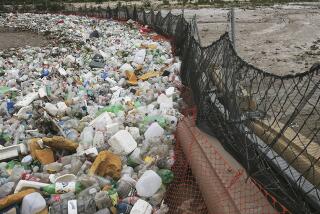Medellin is ready for its close-up
- Share via
MEDELLIN, COLOMBIA — Once the shadowy and violent domain of drug kingpin Pablo Escobar, Medellin has undergone a renaissance over the last decade due to enlightened civic policy and public works, offering government officials proof that urban decline can be reversed.
Once one of the world’s deadliest cities, Medellin’s homicide rate has dropped by more than 90% since the mid-1990s. Former rebels and paramilitary fighters are being re-integrated into Colombia’s second-largest city in an innovative program adopted by the nation’s demobilization director.
The urban transit system has been upgraded to include a spectacular tramway that has cut commutes and become the city’s icon.
And then there’s the new sewage system, which has cleaned up the formerly malodorous Medellin River and 24 creeks and greatly improved the city’s image -- and smell. The project has become a regional model for cleanup projects in densely populated areas.
The system, which includes educating residents and businesses near the river on how to prevent pollution, has converted the river district from an open cesspool to a zone where corporations such as Bancolombia and Carrefour have built major facilities.
The sewage system project is receiving $580 million in loans from the Inter-American Development Bank, the Washington-based multinational development lender that is holding its annual meeting here this weekend in part to showcase what leaders believe is a success story.
In an e-mailed statement to The Times, IDB President Luis Alberto Moreno said the project shows that “investing in sanitation can have huge payoffs that go far beyond public health.”
Despite the global financial crisis, the annual meeting is expected to draw 6,500 delegates from around the world, 40% more than last year’s meeting in Miami. Main attractions include a series of presentations by China, which joined the IDB last year as part of its strengthened ties with Latin America.
China is expected to unveil two multimillion-dollar development funds to provide loans for infrastructure and “increase the flow of credit amid the global financial crisis,” according to a preliminary draft of the announcement. China already has invested $4 billion in such a fund in Venezuela.
Another lure for many of the delegates is the host city’s makeover, one so dramatic that its principal architect, former Mayor Sergio Fajardo, is a contender in the 2010 presidential race. Offering education and training in violent neighborhoods was crucial to his goal of offering youths an alternative to drugs and violence, he said Wednesday.
“Whenever we reduced violence in an area, we immediately came up with projects -- libraries, cultural, health and entrepreneurship centers -- in the poorest areas so the community could see the society was providing opportunities,” Fajardo said in an interview.
The bank, which observes its 50th anniversary this year, operates with capital from 48 member countries, including the United States. Its mission includes offering low-cost loans to finance public works and infrastructure to spur economic development and reduce poverty. Last year, the bank authorized $11 billion in new loans.
Some nongovernmental organizations critical of the IDB say the bank has failed to live up to its mission and should be denied the capital replenishment in the billions of dollars that the IDB is expected to request this year from the United States and other members.
Vince McElhinny of the Bank Information Center, a Washington-based watchdog group that monitors multinational lenders, says that the IDB has financed roads and dams in Latin America that have harmed the environment, and that it has backed privatization of water systems that have reduced access for poor families in some countries.
“The bank lost $1.9 billion last year investing in securities it shouldn’t have,” McElhinny said. “On a pure accountability level you have to ask, what happened?”
The bank has responded to such criticism by noting that Standard & Poor’s continues to rate IDB debt as highly secure.
--
More to Read
Sign up for Essential California
The most important California stories and recommendations in your inbox every morning.
You may occasionally receive promotional content from the Los Angeles Times.













